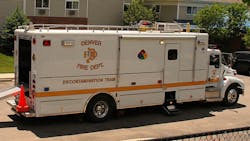Apparatus Exposure Control: Going Beyond the Cab to Protect Firefighters
You can’t see what is lingering at a smoldering fireground, waiting to catch a ride back on your firefighters or apparatus. New research continues to reveal pervasive, invisible cancer-causing carcinogens clinging to firefighters, EMTs and emergency vehicle technicians (EVTs). Firefighter and EVT cancer rates are escalating. What can you do?
Robert Tutterow—cofounder and president of F.I.E.R.O. (Fire Industry Education Resource Organization)—has 40 years of experience in the fire service, 24 years as the health and safety officer for the Charlotte, NC, Fire Department. During his service, Tutterow saw numerous changes in firefighter health and safety. However, the latest research reveals firefighters’ overwhelming exposure to carcinogens on, to and from fireground incidents.
In his presentation “Apparatus Exposure Control: Beyond the Cab” at the Fire Department Safety Officers Association (FDSOA) Apparatus Symposium in Orlando, FL, in January, Tutterow focused on the new research revealing multiple levels of toxic carcinogens found on fire apparatus, gear and equipment.
Tutterow explained that on-scene decontamination, now referred to as “Preliminary Exposure Reduction,” is the first line of defense when involved in heavy, smoke-filled incidents, and offered insight on unseen carcinogens found in and on fire apparatus. He also offered on-scene contaminant-control measures, solutions for storage and transport of contaminated PPE and equipment. Tutterow’s message was clear: If you fight a live fire, invisible carcinogens will cling to firefighters and everything they touch or ride in.
Tutterow explained that in a fire, turnout gear can offer a certain level of protection, but the harmful toxins permeate and linger: “The off-gassing can be smelled by a firefighter’s wife the next day,” he said.
When Tutterow asked the attendees if any departments had removed the SCBAs from their rigs, only three out of 63 attendees in the class raised their hands. One firefighter commented that it wasn’t until after one of their firefighters died from cancer that they removed the SCBAs from their cabs. An officer from Clark County, NV, added, “We got a lot of push back from the guys on the floor after taking the SCBAs out of the rigs.”
In the audience, Keith Tyson from the Firefighter Cancer Support Network, commented that Miami-Dade had recently lost 21 firefighters to cancer. Bruce Varner, former fire chief of Santa Rosa, CA, said Chief Alan Brunacini of the Phoenix Fire Department, removed SCBAs from cabs years ahead of any other department. He added, “When Chief Alan Brunacini retired, Phoenix put SCBAs back in the seats and now they are taking them out again.”
Tutterow directed comments at officers training firefighters with SCBAs in compartments: “As captain, you set the time to come off the truck,” he said. “Make sure firefighters are all on the same page of what they’re going to do when they come off the truck.”
Tutterow showed the video Firefighter PPE Contamination, produced by United Fire Service Women – San Francisco, of a firefighter covered in shaving cream to simulate a “contaminant” and how easily it spreads and lingers on contact.
Viewing photos of the inside of the apparatus cab, Tutterow asked what changes or improvements are needed to make the cab seats easier to decontaminate: “Nothing is 100 percent impenetrable,” he said, suggesting the use of disposable seat covers. “What about covers for seatbelts or belt covers?”
Tutterow prodded the group by asking, “What changes are needed in the cab interiors to make them easier to decontaminate?” What other areas of an apparatus need to be viewed as contaminated? Among responses from the attendees:
- Cab-in air conditioners with high-efficiency particulate air (HEPA) filters
- Grab handles
- Cab floors? “One of the dirtiest gears is footwear,” Tutterow noted.
- Diamond plate floors versus rubberized flooring
- Easy-to-clean cabinets. Tutterow suggested a light color versus the black or gray that is currently in use. “When light colors are dirty, you clean them,” he said.
Tutterow also shared suggestions for being proactive with vehicles on scene. “Place apparatus up-wind if possible and close cab windows, doors and compartments,” he said.
In addition, he shared research provided by the Illinois Fire Service Institute (IFSI) that found more carcinogens from the diesel engines than the fire scene itself: “Get your pump operators to wear SCBA,” he recommended, adding that the Palm Beach County, FL, Fire Rescue Department now has pump operators wear SCBAs.
The Firefighter Cancer Support Network suggested that each fire apparatus carry a kit containing a 5-gallon bucket with decontamination wipes (alcohol or aloe are now available), and provide crews with a procedure for wiping down on scene to include the face, eyelids, nose, ears, neck and head. Another option is to wash with apparatus water. One department retrofitted a hose on the pump panel so firefighters can use a hose to wipe down; however, Tutterow cautioned with the question, “How green is the water in your booster tank?”
When it comes to putting PPE into storage bags for transport back to the station, Tutterow recommended: “Store gear in bags so it’s not off-gassing. Reusable bags are available. If you use disposable bags, make sure they are clear bags because at FDIC, they used black bags and [mistakenly] got tossed out.”
Several new mobile units are being designed to specifically contain, remove and replace contaminated turnout gear and equipment. Recent new deliveries of decon apparatus include Edmonton, Alberta, Fire Rescue, and the Denver Fire Department’s Decon truck.
When it comes to appliances for cleaning equipment, Tutterow presented photos of “washing” machines for SCBA cylinders and dishwasher-type machines for washing helmets.
“If you order new helmets, make sure you can remove helmet liners for cleaning,” he added. “And do not clean footwear in the apparatus bay!”
Perhaps the most surprising element of Tutterow’s presentation called attention to hose cross-contamination. Photos included crews in bunker paints, turnout coats off and no gloves, dragging and re-packing wet fire hose on a rig after an incident. Hose washers are available, Tutterow explained, but how do you protect firefighters while repacking firehose?
Inside the fire station, Tutterow emphasized the importance of getting the ice machine out of the apparatus bay. “When the power went out in one station, the melted water in the ice machine had silt in it,” he said.
Lastly, Tutterow pointed out that the use of diesel exhaust systems in stations and apparatus bays offers multiple opportunities to reduce or capture carcinogens. Source-capture systems can be effective, but Tutterow cautioned, “You’ve got to put it on before you enter the station, and many firefighters don’t do it.”
Onboard exhaust systems also capture toxins and work well on new apparatus, he said. Vertical exhaust systems can be effective, but Tutterow emphasized following manufacturers’ guidelines.

Janet A. Wilmoth | Special Projects Director
Janet Wilmoth grew up in a family of firefighters in a suburb of Chicago. Wilmoth, who is owner of Wilmoth Associates, worked with Fire Chief magazine for 27 years until it closed in 2013. She currently is the project director for Firehouse, overseeing the Station Design Conference.






